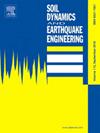Parametric analysis of sedimentary V-shaped canyon for seismic response of canyon-crossing bridges
IF 4.2
2区 工程技术
Q1 ENGINEERING, GEOLOGICAL
引用次数: 0
Abstract
Previous earthquakes reveal that the sedimentary V-shaped canyon (SVC) may result in severe damage of canyon-crossing bridges (CCBs). The seismic response of CCB is affected by various parameters, including sedimentary soil characteristics and fault rupture mechanisms. However, these influential parameters of SVC on the seismic response of CCB have not been sufficiently studied in the existing literature. Thus, this study aims to identify the most influential factor on the seismic response of bridges across SVC using parametric analysis. For this purpose, the spectral element method (SEM) is adopted to simulate the wavefield of SVC considering the fault dynamic rupture. The characteristics of ground motions in the Forward region (FR) and the Middle region (MR) are investigated. The sensitivity of ground motions recorded in SVC to four main influential factors (i.e. shear wave velocity of sedimentary soil Vs, the ratio of sedimentary soil depth to canyon depth d/D, layer sequence O, and fault-to-canyon distance Rrup) is numerically evaluated. Furthermore, the parametric analysis is performed to estimate the impact of these influential parameters on the seismic response of a CCB. The results reveal that the amplitudes of pulse-type ground motions in the illuminated side of SVC increase with the decrease of Vs. As the Vs decreases from 2300 m/s to 400 m/s, the residual deformations of four bearings increase by 293 %, 93 %, 451 %, and 292 %, respectively. When the d/D is 0.3, the velocity pulse ground motions in SVC have the largest PGVs. The base shear of the piers in the case of d/D = 0.3 increases by more than 77.3 % compared to that without considering the sedimentary soil (d/D = 0). The inverted sequence may result in larger seismic responses of bearings and piers compared to normal sequence. Rrup has the most significant effect on the seismic response of CCBs. The higher-order effect and additional plastic hinges are more noticeable when Rrup is less than or equal to 7.5 km.
求助全文
约1分钟内获得全文
求助全文
来源期刊

Soil Dynamics and Earthquake Engineering
工程技术-地球科学综合
CiteScore
7.50
自引率
15.00%
发文量
446
审稿时长
8 months
期刊介绍:
The journal aims to encourage and enhance the role of mechanics and other disciplines as they relate to earthquake engineering by providing opportunities for the publication of the work of applied mathematicians, engineers and other applied scientists involved in solving problems closely related to the field of earthquake engineering and geotechnical earthquake engineering.
Emphasis is placed on new concepts and techniques, but case histories will also be published if they enhance the presentation and understanding of new technical concepts.
 求助内容:
求助内容: 应助结果提醒方式:
应助结果提醒方式:


